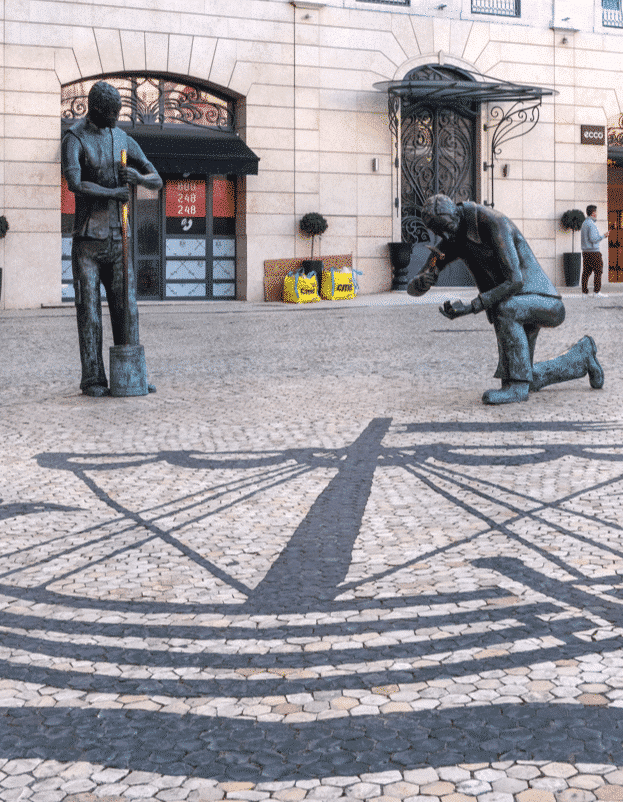Located in the heart of Portugal’s capital city, Lisbon, is a unique monument that pays tribute to an often overlooked profession. The Homenagem aos Calceteiros is a remarkable testament to the individuals who have played a crucial role in shaping and maintaining the city’s distinctive charm. This article will delve into this fascinating piece of history and its significance.
The Craftsmanship of Calceteiros
A calceteiro, or paver as it translates into English, is someone who lays down cobblestones by hand to create intricate patterns on streets and sidewalks. This traditional Portuguese craft dates back several centuries and has become synonymous with Lisbon’s urban landscape.
In fact, calçada portuguesa (Portuguese pavement), as it’s known locally, is not just functional but also artistic. It involves arranging small black basalt stones and white limestone pieces into various designs – from simple geometric shapes to complex mosaics depicting historical scenes or nautical themes associated with Portugal’s seafaring past.
Homenagem aos Calceteiros: A Tribute Monument
In 2006, Lisbon decided to pay homage to these skilled workers with a statue aptly named ‘Homenagem aos Calceteiros’, which means ‘Homage to Pavers’. Situated near Rossio Square at Praça Dom Pedro IV in downtown Lisboa, this bronze sculpture depicts two men involved in their meticulous work – one kneeling while placing cobblestones onto the ground while another stands nearby holding tools used for paving.
The Significance Behind The Monument
This monument serves as more than just recognition for these hardworking individuals; it embodies an important part of Portuguese culture that continues today despite modernisation efforts. As you walk around Lisbon’s historic districts like Alfama or Baixa-Chiado you can’t help but notice the beautifully patterned pavements underfoot, a testament to the craftsmanship of these workers.
Moreover, Homenagem aos Calceteiros also symbolizes Lisbon’s resilience. The city had to be almost entirely rebuilt after the devastating 1755 earthquake. This massive reconstruction effort included laying down thousands of cobblestones by hand which gave Lisbon its unique identity that we see today.
Visiting The Monument
The monument is easily accessible as it lies in one of Lisbon’s busiest squares and is free for everyone to visit. It offers an excellent photo opportunity and a chance to appreciate a piece of local history often missed by tourists. While there, take time to observe the intricate details – from each individual cobblestone being placed with precision, right down to their tools – all crafted meticulously on bronze.
In Conclusion
The Homenagem aos Calceteiros not only pays tribute to this traditional craft but also serves as a reminder of how much hard work has gone into making Lisbon what it is today. So next time you find yourself strolling through Lisboa’s cobbled streets, spare a thought for those who have painstakingly laid them out by hand and consider paying this special monument a visit!
Frequently asked questions
What is Homenagem aos Calceteiros in Lisboa?
The Homenagem aos Calceteiros, or Tribute to the Pavers, is a public artwork located in Lisbon, Portugal. It was installed in 2006 as a tribute to the city’s traditional pavers (calceteiros) who have been manually laying cobblestone roads across Lisbon for centuries. The monument consists of two life-sized bronze figures depicting calceteiros at work and an actual piece of cobblestone road.
Where can one find the Homenagem aos Calceteiros?
Homenagem aos Calceteiros can be found on Rua da Vitória in Baixa district, which is considered downtown Lisbon. It’s near Praça Dom Pedro IV square (also known as Rossio Square), making it easily accessible for tourists exploring the heart of the city.
Who created this tribute and why?
The sculpture was created by Sérgio Stichini and architect Francisco Silva Dias. They designed it with an intention to honor and preserve the tradition of hand-laid cobblestones that give many streets in Lisbon their distinctive appearance. These artisans are integral contributors to Lisbon’s unique cultural heritage, but their craft has become less common due to modern paving methods.
What significance does this tribute hold?
This tribute holds significant historical value as it represents a dying art form that has shaped much of Lisbon’s aesthetic appeal over centuries. The intricate patterns seen on many sidewalks around town were all painstakingly laid by hand using small cubes of limestone – a labor-intensive process depicted by these sculptures. By celebrating this craft through public art, Lisboetas hope to ensure its story remains part of their urban landscape even if future generations abandon manual paving techniques.
Can I visit the Homenagem aos Calceteiros?
Yes, you can visit the Homenagem aos Calceteiros. It is located in a public space and accessible 24/7. There is no entrance fee to view this tribute as it’s an outdoor display on a city street. However, please respect the artwork by not touching or climbing on it to ensure its preservation for future generations.












